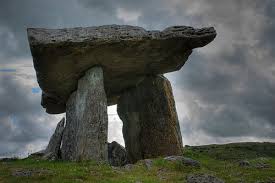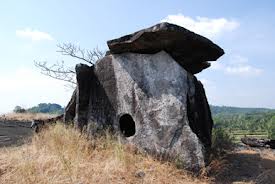Karkala;August 24 :The press release issued by the Professor states that the discovery was done on July 26. Megalithic Culture was a dominant culture of South India and coastal Karnataka.
This culture has been known by its varied types of burials, deliberately constructed with great care and reflects the strong belief of life after the death of those people.
 The dolmens were square or box like graves built of several orthostatis, one or more for each side, supporting the super incumbent capstone, often with the floor also paved with the stone slabs.
The dolmens were square or box like graves built of several orthostatis, one or more for each side, supporting the super incumbent capstone, often with the floor also paved with the stone slabs.
The orthostats and capstones might be formed either of undressed rough blocks of stone or partly dressed flattish stones. They were generally identified as “Pandavarakallu,” “Panara arekallu,” “Tunt or Tutukallu” in South India and in coastal Karnataka.
In Palli, the Megalithic site located on the right side of Palli-Karkala road and locally known as “Madmal Pade” which means bridal stone. There was semi granite out crop and is now under smash by stone quarrying.
On the southern slope of this granite hill, a dolmen survives in a slightly better condition. This dolmen is locally called as “Madmal Gunda” by the people. Madmal pade dolmens are comparable with the dolmens of Borkatte near Karkala and Rajana Kuluru of Northern Karnataka in style and appearance.
Hence, they may be dated back to 800 BC comparatively. It was built roughly square and its port hole oriented to the east. The four orthostats joined each other in the clock wise manner which formed a rough square cell. It was covered by a big stone slab as a capstone. Inside this cell, the earth was filled up to the lower level of port hole.
Another dolmen found in a bush was totally in dilapidated condition and found at the ground level in the broken condition. A rough square cell has been made by using big stone slabs. However, the southern orthostat was missing.
Nearby, within five foot of distance to north, vestiges of two more dolmens were found. One is located inside of Brahmasthana, another one found in adjacent. Due to heavy rains and religious attachment, it was unable to clear the site properly.
On the whole, the preliminary observations clearly indicate that the site under study is a promising megalithic site and needs to be given additional attention.
A small quantity of red, black and red and black pottery was collected, from the inside surface of the first burial, which indicate the existence of grave goods in the burial.
The final year archeology students of Mulki Sunder Ram Shetty College (Shirva) were also part of the discovery process, according to a press release.
DHN



